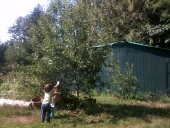posted 7 years ago
Apple seeds from my best 3 seedling trees (Western Maine zone 3)
These seeds come from seedling apple trees which grow well for me in the mountain foothills of Western Maine. USDA zone 3. The coldest part of winter can get below -30F, and the hottest part of summer can get above 120F. In my localized climate, the winter is approximately 6 months long. Spring and autumn are very short and wet. Spring is often divided into 2 seasons here: Flood Season and then Mud Season. Summer is very hot and humid with little rain. The most common apple diseases here are Fireblight, Scab, Crown Rot, Powdery Mildew, Black Spot Canker, Black Knot, Sooty Blotch. The worst diseases for apple trees here are Crown Rot and Canker.
For reference, most commercial rootstocks are not vigorous or hardy enough to survive in my climate. EMLA 111 is an exception, but cannot withstand the spring flooding and only grows about 1 foot per year. Geneva 969 is an exception as well. G969 grows ok in my climate, and can withstand flooding, but puts on only about 6 inches of growth per year.
I am giving away seeds only, for my best 3 seedling apple trees. No root cuttings at this time. But I need to know in advance how many seeds to save out before the apples end up being sold or pressed for cider. I will send 20 seeds per tree. I am not going to put a dollar amount on the seeds, but a donation would be helpful. So, if you are interested, then please respond with a post and let me know which trees you are interested in, and I will message you for shipping details when the seeds are ready. Shipping only to USA and Canada.
"Little Yummy" - No sign of disease. No vole damage. Seeding tree grows in a site that floods every spring. The fruit is a 2 inch wide yellow and red pearmain, sweet with very slight acidity. Ripens in September. Low vigor. The tree is only around 14 feet tall at around 20 years old. Spur-bearer. Bears fruit every year. Had 2 inch long spikes for thorns when it was young, which disappeared when the tree started bearing fruit. This tree has been propagated from root cuttings, however, seeds will be from the original tree. Very few root suckers.
"Winter Pie" - No sign of disease. No vole damage. Seedling tree grows in a site that floods every spring. The fruit is 2 inches in diameter, roundish, often lopsided, yellow with russet blotches. Spur-bearer. The taste is very sweet, very acidic, and slightly bitter. Makes delicious pies and hard cider. Fruit is ready to pick 1 week after first autumn frost and stores at room temperature until May. Bears fruit most years. This tree grew to over 40 feet tall in less than 15 years. Puts on over 4 feet of new growth per year. This tree has been propagated from root cuttings, however, seeds will be from the original tree. Makes for a decent rootstock, but OCM-21 is better.
"OCM-21" - No "proper" name yet, as I don't sell the fruit. No sign of disease. No vole damage. Seedling tree grows in a site that floods every spring. The summer ground water level is about 1 foot below the surface where this tree is, so the roots of this tree are always wet. The fruit is a 4 inch wide yellow and pink pearmain. Bears fruit on tips and spurs. Not sure how tall it would have grown, since I severely pruned it when it was around 30 feet tall at 9 years old. The fruit is ready to pick 3 days after the first autumn frost. The flavor and texture is reminiscent of Cortland, but the flavor degrades very quickly. After a month of storage, the apple tastes like a potato. Best used for rootstock, or for cider to be pressed within one week after picking. This tree has been propagated from root cuttings, however, seeds will be from the original tree. No root suckers, and the roots are thick, barely flexible, and stronger than oak which makes propagation difficult but well worth it. This is my main rootstock variety. My most vigorous apple tree. This is a solid tree. Grows straight and tall, probably because of the thick, strong roots. Loves water. Grows okay in dry areas too. Puts on over 5 feet of new growth per year.

 9
9








 2
2
























































